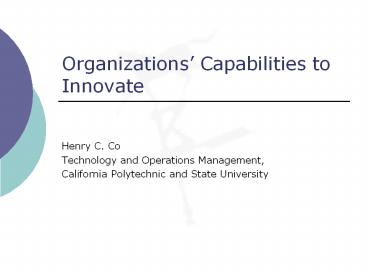Organizations - PowerPoint PPT Presentation
1 / 19
Title:
Organizations
Description:
Requisite knowledge, skill, perspective, energy and physical strength. ... The Boston Celtics in the 60s. Where Do the Organization's Capabilities Reside? ... – PowerPoint PPT presentation
Number of Views:55
Avg rating:3.0/5.0
Title: Organizations
1
Organizations Capabilities to Innovate
- Henry C. Co
- Technology and Operations Management,
- California Polytechnic and State University
2
Recapitulation APP Plan
3
(No Transcript)
4
An Individuals Capabilities to Innovate
- Ability
- Judgment
- Value
5
Right Person for the Right Job?
- Requisite knowledge, skill, perspective, energy
and physical strength. - Judgment the way an individual evaluates and
combines information from various sources, in
order to reach decisions and solve problems. - Values the criteria by which an individual
tends to decide what should and shouldn't be
done what-is good and what is not.
6
Right Organization for the Right Job?
- Organizations have capabilities and disabilities.
- Take two sets of identically capable people
working on a project and put them to work in two
different organizations, what they accomplish
would likely be significantly different! - Factor that affect what an organization can
accomplish - Values (non- transferable)
- Processes (non- transferable)
- Resources (transferable).
7
Factors that Affect What an Organization Can
Accomplish
- Values
- Processes
- Resources
8
What are Values?
- Criteria by which decisions are made standards
by which employees judge. - Whether an order from a customer is a piece of
good business or unattractive business - Whether a customer is an important one whose
inputs should be solicited and valued, or is
unimportant - Whether a new product idea is attractive or not
- Whether a product whose dimensions hover at the
outer bound of accepted tolerances should be
shipped or not etc.
9
Clear and Consistent Value
- Employees at multiple levels can make independent
decisions that are consistent with the strategic
direction and business model of the company. - Values reflect a consensus about what makes sense
for the company and the individuals within it. - GOAL CONGRUENCY!
10
What are Processes?
- Patterns of communications, interaction,
coordination an work through which inputs
(information, material, equipment, technology,
labor, and money) are transformed into
products/services. - Process differ in
- purpose,
- visibility (formal versus informal),
- embedded routines (Thats the way we do things
around here.) - Processes and Efficiency
- Two different organizations with identical sets
of inputs, one might create more value than the
other.
11
What are Resources?
- People, equipment, technology, product designs,
brand reputations, information, cash, and
relationships with suppliers and customers. - Resources assets that can be hired and fired,
bought and sold, upgraded and depreciated. - Transferable across the borders of organizations
much more readily than processes or values. - Knowledge and skills of a person reside in the
individual, and leave the organization if he or
she leaves. - Processes and values reside with profound
resilience within the organization.
12
Alternative Strategies for Improving Performance
- Resources, processes and values all affect an
organization's performance different companies
can weight these factors differently in their
strategies to improve performance.
13
Alternative Routes To Performance Improvement
- Superior process
- Hewlett Packard relied on its design process,
whereas IBM relied on resources in the form of
high-performance components. - Hewlett Packard's design strategy was to use
components that were a step behind the state of
the art, but to wring maximum performance from
them through efficient system design. - IBM's strategy, in contrast, was to employ the
most advanced components available, but its
system designs were mediocre.
The result was that the two firms' products were
comparable in performance.
14
- Superior resources
- GM invested 60 billion during the 1980s in
automated manufacturing equipment to improve
quality and reduce cost. - The Los Angeles Lakers in the 60s.
- Superior organizational capabilities.
- Toyotas strategy was to employ less
sophisticated equipment and to hone its processes
to make better products. - The Boston Celtics in the 60s.
15
Where Do the Organization's Capabilities Reside?
- Capabilities of an organization reside in its
processes and values. Processes and values define
what an organization can and cannot do with a
given set of resources.
16
Core Capabilities
- Organizations Capabilities
- Organizations core capabilities reside in its
processes and values. - Processes and values define what an organization
can and cannot do with a given set of resources. - Core Capabilities and Core Rigidities
- Processes and values that have enabled certain
type of innovations in the past, can act to
constrain the efforts of capable employees to
innovate in different ways. - Processes tend to facilitate an organizations
ability to create value when new task matches
closely the task for which the process was
originally designed. The same process, however,
can impede employees efforts to execute other
types of tasks.
17
Heavyweight Teams
- Vehicles for Creating New Process-Based
Capabilities
18
- Lightweight teams
- To exploit the capabilities that are rooted in
the organizations established processes and
values. - Members are assigned to represent the interests
and capabilities of marketing, engineering,
manufacturing, finance, procurement, etc. The
teams primary role is a coordinative one. - Heavyweight and autonomous teams
- Vehicles for building new processes and values --
new capabilities. - Possess full authority to make all decisions
required for the project to be successful.
Members take collective responsibilities for the
successful execution of every aspect of the
project.
19
(No Transcript)

